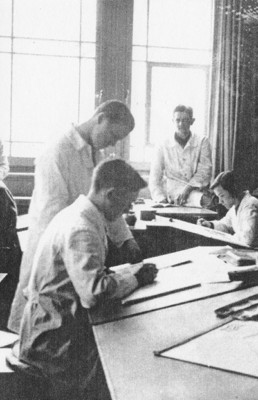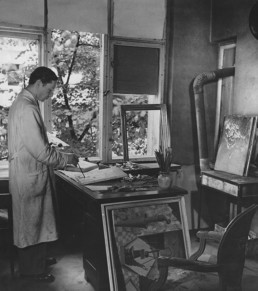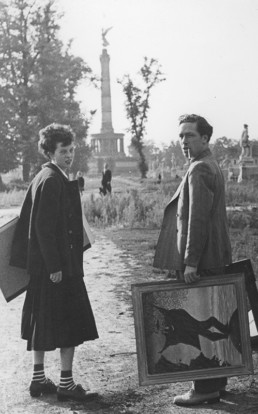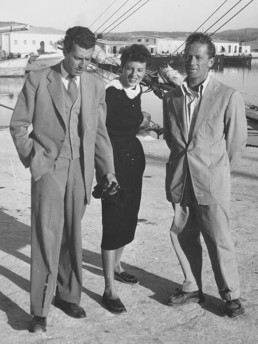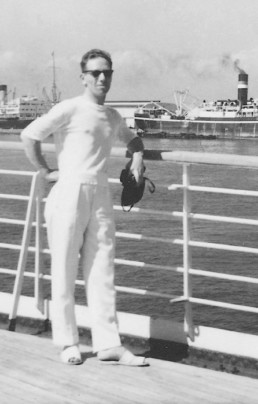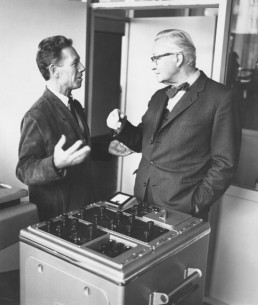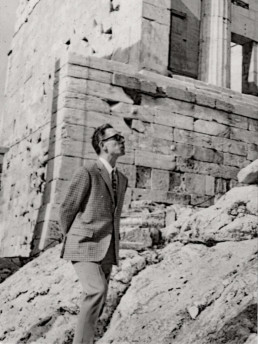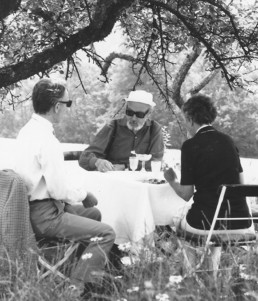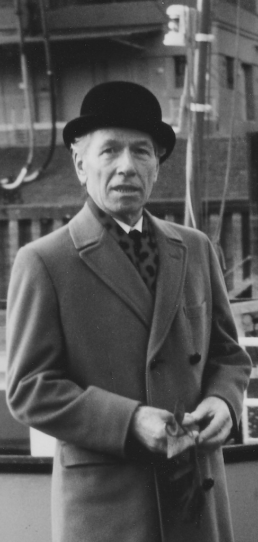I believe in the creative in the world and in people, that art will endure and that it is worth living in our century, despite everything. Don’t become timid, don’t let yourself be upset by big talk, doubt, smile, let yourself be surprised, even by yourself, experience our world with keen senses.
The terrestrial zoo is large and has room for many species; the higher of them are our good fortune and our comfort. I would like to call them poets, who see our world in a new way, in colours, words, shades and equations, as we have not yet known it, who reveal unparalleled wealth.
I believe in the greats of our time, in the creative, artistic contributors to the building of a new world, of which I can confidently presume that it will be of no lesser a nature than the one mourned by so many. I also believe in the fervent provocateurs of our turgid hearts, in the holy fools who tell our fortunes, in the dalliers who stroll about or lie in the sun, in the dreamers, in the fatuous, in the spiritual rebels (not in the ideologues), in those as free as possible and in those yet to come, who we do not yet know, but who are already quietly asking other questions. I should name names. That would be a long list and would amount to a very good total – for the last fifty years.
So: Mies van der Rohe, Picasso, Klee, Gropius, Mondrian, Einstein, Charlie Chaplin, James Joyce. Arnold Schöneberg, Miró, Wols, Louis Armstrong, Bert Brecht, Saint John Perse, Paul Celan, Saul Steinberg, Luther Burbank, Apollinaire, Bonnard, Max Ernst, Brancusi, Giacometti, Gonzales, Le Corbusier, Frank Lloyd Wright, Aimé Césaire, Kafka, Dior, Charles Lindberg, Grock, Tristan Tzara, Albert Schweizer, Henri Rousseau, Wilhelm Uhde, Hemingway, James Ensor, Kandinsky, Elisabeth Bergner, Alvar Alto, Hélena Rubinstein, Stravinsky, Henry Miller, Henry Ford, Braque, Felix Krull, Kontiki, Haile Selassie, “Ella”, Garbo, Chagall.
I know, I know. The list is contestable and is also not complete. I could continue it any way I wish. No, not any way. Politicians, ecclesiastical princes and generals are absent, for example. Because I don’t believe in them. It is difficult to believe in something at a time in which many old terms no longer possess any validity, which we no longer comprehend with naked reason, the sense and secret order of which we can hardly still experience, in face of all the threat and terror, in face of the towering, filthy clouds. I am also familiar with this great lost doubt, these black days and nights, this anxious gaze of the rabbit in the face of the functioning chaos, the twitching greed, a friendly message, which hopes to turn everything to the good with one blow. I am familiar with this numbness that hangs over us like a mute bell. And nonetheless, only we ourselves can make it sound; not with the avid thrashing about of the bell ringer, but instead with quiet overtones. But here we must learn to listen, irrespective of whether we are transmitters or receivers. To do so, we must enter into silence and be capable of remaining alone. Each of us can only believe for ourselves. External creeds are not prescriptions, and we shouldn’t fool ourselves. I believe in the exception that confirms the rule and in the errors in the system. I don’t believe in any direction, and not in any art movement. However, I do know that the art of our time must look different than that of 1890. This new art, so often wished dead, has already been alive for a half a century now. Not even the rococo lasted that long. And how diverse, how rich, how nuanced and full of imagination (see the list of names, the incomplete list). I believe in the creative power in art, but not only in the number one dress uniform, but instead also in those who form the humus, who impregnate the air with art bacilli and ensure a generally spiritual climate.
Our atmosphere, with its implicit faith in progress and obedience to technology, must be enriched more with these other bacilli originating from the districts of art, dreams, imagination, the creative, from the realm of the muse and leisure. Give art more of an opportunity to heal our times, to create beauty, to organise celebrations for our inner gaze. I believe that helps, that delights and makes us more human than we are now.
Heinz Trökes, “Daran glaube ich” [What I believe in], Hamburg 1957
1913 – Born 15 August in Hamborn/Rhine (today part of Duisburg).
1930 – Trip to the Netherlands and Luxembourg.
1932-1933 – Attendance of the arts school in Krefeld.
1932 – Cycling tour through Switzerland, Italy, France and Luxembourg.
1933 – Abitur (German qualification for university entrance)
1933-36 – Pupil of Johannes Itten in Krefeld.
1934 – Three-month bicycle tour through Italy. Visit to art locations in Florence, Rome, Naples, Palermo and Venice.
1936-39 – Painter in Augsburg. Secured an existence with textile designs for J.P. Bemberg.
1937 – Encounter with Wassily Kandinsky in Paris.
1938 – First solo exhibition in the Berlin Galerie Nierendorf, which was closed at the instigation of the Nazis. Followed by expulsion from the Reich Chamber of Culture with exhibition and work proscription until 1945. Travels to Vienna, Budapest, Yugoslavia and Italy.
1939 – Resettlement to Zurich in order to emigrate from there to the Dutch Indies (Indonesia), which was made impossible by the outbreak of the Second World War. Return to Germany.
1940 – Programme of study with Georg Muche (Master class) in Krefeld.
1940 – As common soldier with anti-aircraft in Berlin. Attendance at the art school of Max Dungert in Berlin during his free time. Deserted in August 1944 and lived illegally in Berlin.
1945-1946 – Co-founder of the Berlin Galerie Gerd Rosen, the first private art gallery in Germany following the war. Artistic director there until 1946. Several art history essays, including ‘Moderne Kunst in Deutschland’ [Modern art in Germany], ‘Der Surrealismus’ [Surrealism] (in: Das Kunstwerk, 1st volume, 1946/47, no. 8/9) and ‘Moderne Kunst und Zeitbewusstsein’ [Modern art and consciousness of time] (in: Bildende Kunst, 2nd volume, 1948, no. 3).
1946-1948 – Cosmonautical images like ‘Die Mondkanone’ [The moon cannon], ‘Terrain der Kosmologen’ [Terrain of the cosmologists], ‘Sphärische Kontraste’ [Spherical contrasts] and ‘Zwei Welten’ [Two worlds].
1947 – February, reconstitution of the Deutscher Künstlerbund [Association of German Artists]; board: Karl Hofer, Karl Schmidt-Rottluff, Ernst Fritsch, Heinz Fuchs, Heinz Trökes, Gustav Seitz, Renée Sintenis, Richard Scheibe, Hans Uhlmann.
1947 – Called to the Staatliche Hochschule für Baukunst und bildende Künste [College of architecture and fine arts] in Weimar (together with Mac Zimmermann). Conclusion of teaching activity after one semester. Participation in the exhibition ‘L`Art Allemand Moderne – Deutsche Kunst der Gegenwart’ in Baden-Baden.
1948 – Member of the Neue Gruppe [New group] in Munich and the Zone 5 group in Berlin.
1948-1949 – Stay in Rodenbach near Neuwied on the Rhine during the Berlin blockade, then return to Berlin.
1949 – Marriage with Renata Severin. Founding member of the Berlin Neue Gruppe. Article in the magazine ‘Les Temps Modernes’, Paris (Dir. Jean Paul Sartre) on ‘La peinture et le public en Allemagne. L’ Inflation d’expositions et le scandale qu’ elles provoquent’. Solo exhibition in the Kaiser-Wilhelm-Museum, Krefeld. Participation in the ‘Kunst in Deutschland 1930-1949’ [Art in Germany, 1930-1949] exhibition in Zurich.
1950-51 – Prizewinner of the Blevin-Davis competition, Munich. Residence in Paris. Friendship with Wols and Paul Celan. Links with the Rixes group with Matta, Serpan, Riopelle, Zañartu, etc. Participation in the weekly Jour Fixe around André Breton (Perét, Duchamp, Toyen, Ernst, Tamayo, Hérold).
1952 – Emigration to Ibiza, Spain at the beginning of the year, resulting in many island pictures, often with a topographical character. Prizewinner of the Hallmark competition, New York. Solo exhibition in the Galerie Jeanne Boucher, Paris.
1953 – Solo exhibitions in the Museum von der Heydt, Wuppertal, and in the Städtisches Museum [Municipal Museum], Braunschweig. Participation in the São Paulo Art Biennial.
1954 – Birth of his son Jan Manuel. Travels from Ibiza to Zurich, Berlin, Paris and Barcelona. Exhibition participation: ‘duitse kunst na 1945’, Amsterdam, Stedelijk Museum.
1955 – Deutscher Kritikerpreis for fine arts.
Participation in the 1st documenta in Kassel. Teaching offers of the art colleges and academies in Berlin, Karlsruhe, Zurich, Stuttgart and Frankfurt, which he declined to accept.
Travels from Ibiza to Madrid, Alicante and Toledo. Solo exhibitions in the Städtisches Kunstmuseum [Municipal art museum], Duisburg and in the Galerie Buchholz, Madrid.
1956 – Berliner Kunstpreis (Berlin art prize].
Travels from Ibiza to Andalusia and Morocco. Solo exhibitions in the Haus am Waldsee, Berlin and in the Kunstverein [Art association] Hamburg.
1956-1958 – Head of the Department of Free Graphics of the Staatliche Hochschule für bildende Kunst (now HFBK) in Hamburg.
1957 – Mosaic at the Triennale Milano.
1958 – Three-month trip to Ceylon (now Sri Lanka] and visits to Cairo, Djibouti, Aden and Bombay. Watercolours for the volume ‘Singhalesische Miniaturen’ [Singhalese miniatures] arose from a visit to a rubber plantation. Participation in the Venice Biennale. Glass window for the Interbau in the Hansaviertel, Berlin. Return to Ibiza.
1959-1960 – A year on the island Aegina in Greece. Following the strongly pronounced colourfulness of the Paris and Ibiza years, quiet pictures in reduced and atmospheric colours arose in the differentiated light of Greece, continuing until 1966. Often in Athens, travels to Crete, Rhodes, the Peleponnese and to Istanbul.
1959 – Participation in the 2nd documenta, Kassel.
1960-1961 – Through Berlin, Wameln (etchings ‘Wamelner Folge’ [Wameln series]), Paris, Barcelona and back to Ibiza. Three rug designs, executed by the company Anker-Teppiche, Düren.
1961 – Member of the Akademie der Künste [Academy of Arts], Berlin.
1962-1965 – Alternating between Ibiza and Stuttgart. Teaching position at the Stuttgart State Academy of Art and Design.
1964 – Extended travel through Latin America: Curaçao, Caracas, Peru, Bolivia, Ecuador, Colombia, Panama, Guatemala, Mexico and New York. The illustrated book “Eldorado” originates from these travels. Karl Ströher Prize of the 1st Internationale der Zeichnung [International of drawing], Darmstadt. Solo exhibition in the Museo de Bellas Artes, Caracas.
Participation in the 3rd documenta, Kassel.
1965 – Called to the Hochschule für bildende Künste, Berlin (today Berlin University of the Arts (UDK)). Professor/head of the class for free painting. Since then, residing in Berlin and on Ibiza.
Church window in Leonberg near Stuttgart. Travel through northern and southern Spain to Madrid and Morocco. Solo exhibitions in the Kunstvereinen (art associations] of Pforzheim, Mannheim and Oldenburg.
1966 – Experiments with Georg Muche on a helioclichograph in Kassel, with the aim of generating electrically controlled prints. Travel to Portugal. Quiet pictures succeeded by intensely colourful images with folkloric elements.
Solo exhibition in the Museu de Arte Moderna (MAM), Rio de Janeiro.
1967 – Travels to Argentina, Brazil and Senegal. Solo exhibition in the Wilhelm-Lehmbruck-Museum, Duisburg.
1968 – LSD painting experiments with Dr Hartmann, Munich. Honorary member of the Accademia Internazionale ‘Tommaso Campanella di Lettere-Arti-Scienze’, Rome. Solo exhibition in the Landesmuseum (State museum) Oldenburg.
1968-1970 – 64-colour illuminations for the eight-volume collected edition ‘Crébillon’.
1969 – Travels to Cuba and Denmark. Solo exhibition in the Kunstverein Mannheim.
1970 – Travels to Ethiopia, Ankara and Anatolia.
1971 – Multicoloured and often large format pictures succeeded by two-colour, smaller formats. Second Ethiopia trip and second South America trip: Bolivia, Peru, Panama, Honduras, Guatemala, Mexico.
1972 – Seminar for free painting at the International Summer Academy in Salzburg. Travels to Tunisia, Algeria, Central Sahara.
1973 – Black-and-white collages and China ink drawings, several sketchbooks. Solo exhibition in the Landesmuseum Oldenburg.
1974 – Four-month travels in Asia: Sri Lanka, Burma, Thailand, Malaysia, Indonesia, Nepal, India, Pakistan, Afghanistan, Iran.
1975 – Travels to Switzerland, France, Portugal and Spain.
1976 – Four-month world tour: Israel, Thailand, Bali, Australia, South Pacific, Chile, Argentina.
1977 – Lectures in the Tel Aviv Museum and in the Israel Museum in Jerusalem on ‘Art in Germany under Hitler and afterwards’. Travel to South Yemen and to the clay skyscrapers in the Wadi Hadramaut.
1978 – Four Gobelin tapestries are woven in the Fränkische Gobelin-Manufaktur following motifs of the portfolio ‘Karneval in …’ [Carnival in …]. Colouring of a 17-storey residential block in Berlin-Schöneberg. Concluding of teaching activity at the Hochschule der Künste Berlin. Egypt trip.
1979 – Travels to Cyprus and Crete. Solo exhibitions in the Akademie der Künste, Berlin and in the Wilhelm-Lehmbruck-Museum, Duisburg.
1983 – Solo exhibition in the Nationalgalerie, Berlin.
1993 – Heinz Trökes was awarded the Mercatorplakette (Mercator emblem] for special services to the City of Duisburg on 15 August by Mayor Josef Krings.
1997 Renée passed away on 1 April, and Heinz Trökes on 22 April in Berlin, where both lived constantly since 1965.


